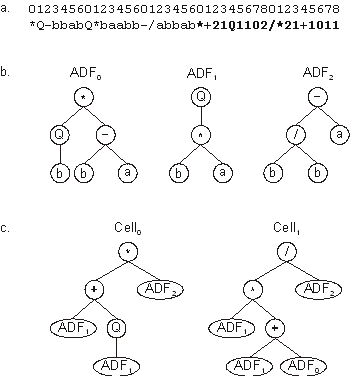|
The use of more than one homeotic gene results obviously
in a multicellular system, in which each homeotic gene puts together
a different consortium of genes.
Consider, for instance, the following chromosome:
|
012345601234560123456012345678012345678 |
|
|
*Q-bbabQ*baabb-/abbab*+21Q1102/*21+1011 |
(12) |
It codes for three conventional genes and two homeotic
genes (shown in blue). And its expression results in two different
cells or programs, each expressing different genes in different ways
(Figure 9). As you can see in
Figure 9, ADF1 is used twice in both cells; ADF2
is used just once in both cells; and ADF0 is only used in
Cell1.

Figure 9. Expression of a multicellular system with three
Automatically Defined Functions. a) The chromosome composed
of three conventional genes and two homeotic genes (shown in bold).
b) The ADFs codified by each conventional gene. c) Two
different main programs expressed in two different cells. Note how
different cells put together different combinations of ADFs.
The applications of these multicellular systems are
multiple and varied and, like the multigenic systems, they can be
used both in problems with just one output and in problems with
multiple outputs. In the former case, the best program or cell
accounts for the fitness of the individual; in the latter, each cell
is responsible for a particular facet in a multiple output task such
as a classification task with multiple classes.
It is worth pointing out that the implementation of multiple main
programs in Genetic Programming is virtually unthinkable and so far
no one has attempted it.
|
